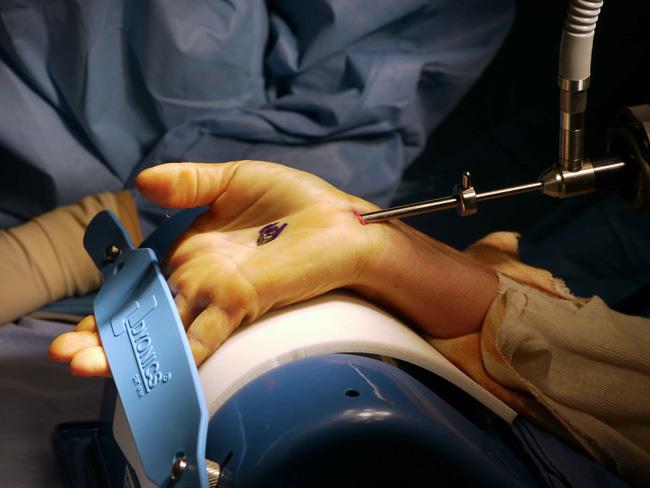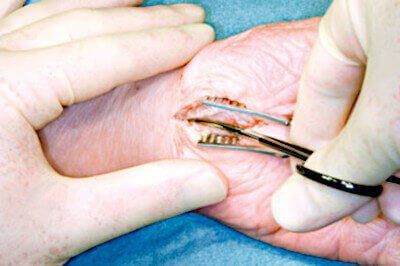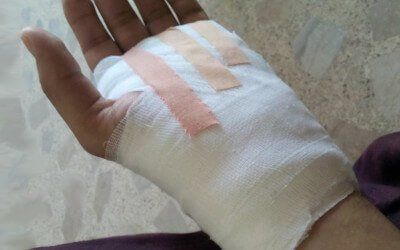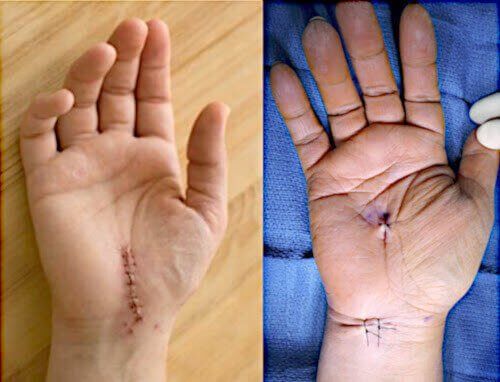Here's What to Expect After Carpal Tunnel Surgery
From Dr. Z - Carpal tunnel syndrome specialist
What to Expect After Carpal Tunnel Surgery
Has your doctor told you what to expect after carpal tunnel surgery? If you’re still wondering, you probably didn't get all the answers you wanted.
If you're thinking about having this hand surgery you must feel comfortable with your decision. No doubt, you need to do something to get rid of the terrible carpal tunnel symptoms. So surgery seems like the way to go.
To arrive at this point about needing surgery, most patients have been living with severe carpal tunnel syndrome for at least 6 months. So who could blame you for wanting to end the punishing pain or crushing numbness in your fingers or hand?
In fact, many patients tell me, "I feel like cutting my hand off!"
- FIND OUT: do you have carpal tunnel?
No strings attached self-test.
Patients come to the surgery decision because these symptoms are never-ending. They rob your sleep and just make life miserable.
Hopefully your doctor tried all non-surgical treatments first because many are quite effective. But if you've tried everything with no results, carpal tunnel surgery may be your only alternative.
Here's what happens during the operation and what to expect after the surgery is over.
After you've considered everything here, weigh all the advantages and disadvantages of surgery (including the type of surgery you'll have) with your doctor. After that discussion and doing your homework, you might find that surgery isn't the magic bullet you're hoping for.
Types of carpal tunnel syndrome surgery
The carpal tunnel doctor you chose will recommend performing one of two basic types of carpal tunnel hand operations:
Endoscopic carpal tunnel surgery uses an endoscope. It’s a thin tube inserted into the palm that contains a fiberoptic camera. Sometimes a scalpel is inserted along with the endoscope (single portal technique). Other times, a second hole in the hand is needed to insert the scalpel (double portal technique).
In contrast, open release carpal tunnel surgery requires a 2-3 inch long cut on the palm. This is needed to clearly visualize the overall structures inside the wrist.
Every other part of these two types of operations are almost the same. They aim to cut the ligament that holds the wrist bones together. When the ligament is cut, the bones spread apart and relieve compression on the median nerve deep inside.
The biggest difference between the two techniques is what to expect after carpal tunnel surgery is over. That's because there's much less trauma to your hand with the endoscopic technique. And that's the huge advantage of endoscopic carpal tunnel surgery compared to the open release technique. It means:
- There's much less
recovery time. The reason is because the endoscopic technique avoids cutting the palm wide open to expose the ligament deep inside.
- With endoscopic surgery, the resulting scar is much smaller. There's less post-surgical pain, it heals faster, and cosmetically, the scar looks better.
But the disadvantage of endoscopic carpal tunnel release surgery is that it's slightly more risky than the open release method. In open release surgery, the long incision lets the surgeon clearly see all of the structures inside your wrist.
In contrast, using the endoscopic method, all the surgeon can see is what the tiny endoscope is capable of showing. That means there's a greater chance of cutting something important, like a nerve or blood vessel. There's also a greater chance of incompletely cutting the ligament. That means symptoms won't go away.
After surgery
Immediately after carpal tunnel surgery
Carpal tunnel surgery recovery begins right after leaving the operating room. When you recover well enough from the anesthesia and the staff is satisfied there are no complications, you're cleared for discharge. Then somebody else must drive you home.
- Pain pills: At home the pain medicines you had during surgery will start to wear off. This is when you begin to feel the
post-surgical pain. But prescription and over the counter medicines will help ease the discomfort quite well.
- Sleep: You will need to sleep with your hand elevated until the stitches are removed. This helps reduce swelling and pain.
- Keep bandages dry: You cannot get the surgical bandages wet, and they must be kept clean.
- Movement: Activities with your hand are limited. But you should wiggle your fingers periodically to keep them from freezing up.
- Stitches removed: You'll return to the doctor in about 10 days to remove the stitches. Hopefully by then the surgical pain will be gone.
The symptoms of carpal tunnel syndrome like pain and numbness may or may not be gone by the time stitches are removed. For some, they go away quickly. But for others it might take weeks or even months for that to happen.
In some patients, the symptoms never resolve completely. In fact, about 50% of patients are dissatisfied with their results by year 2. About 25% of those patients have another (“revision”) carpal tunnel surgery. Sadly, about 68% of those revision surgeries fail.
What to expect after carpal tunnel surgery 1-2 months later
No matter which type of carpal tunnel surgery you had, you will have restrictions in your activities. All patients must avoid heavy use of their hand for several weeks. Rehabilitation to restore hand strength will take from 1 month up to a year.
Overall recovery depends on two major factors.
- First, if you had open release surgery, it will require more recovery time than endoscopic surgery.
- Second, if surgery was on your
dominant hand it will make recovery time longer and more difficult.
The influence these two factors have on recovery time is significant. They can contribute to complete recovery in a few weeks versus a few months (or even a year).
If surgery was not on the dominant hand, patients usually return to work in 2-4 weeks. But if your work requires a lot of hand activity then returning may take a few months.
Note that if your job is especially stressful on your hand, then things are different. Examples of hand-stressing jobs are those with long hours of typing or using heavy equipment or hand tools. About 85% of these workers never return to that job. Therefore, whether or not you return to work (and when) primarily depends on what you do with your hands at work.
Returning to a normal life also depends on the effort you put into rehabilitation and physical therapy. Of course, your own speed of recovery and healing as well as the existence of chronic illnesses are other key factors. But nobody has control over them.
Risks of surgery
Most people wondering what to expect after carpal tunnel surgery fail to see the bigger picture. That is, there are real and significant risks with surgery. This goes for open release or endoscopic surgery.
A big downside is that the surgery might fail altogether. That's why numerous studies show that about half of patients are dissatisfied with their results two years later.
Not getting symptoms relief from surgery is one thing. But other complications may arise like nerve damage, prolonged pain, and permanent hand weakness. General risks of surgery include infection at the site of the incision or below the skin. You also risk systemic infections. There is also a risk of reaction to the anesthesia; a complication that can have life-threatening consequences. Of course, as with all surgery, there is a risk of death, but such rarely happens during carpal tunnel surgery.
Conclusions
If your doctor discussed what to expect after carpal tunnel surgery, no doubt your long term outcome was mentioned. Your results will depend on many factors. For instance, it will depend on which hand was operated on, and whether you had endoscopic or open release surgery. Those two factors make the biggest difference in your recovery time. Also, whether or not you have complications greatly affects what your hand function will be like.
Hand surgery is a major step in your life. Be sure to discuss all of the possible outcomes with your doctor. And also discuss the non-surgical options you can try before deciding on surgery.







